Evolution of pool coatings: From clay tiles to high-performance polymer finishes
by arslan_ahmed | September 8, 2023 11:23 am
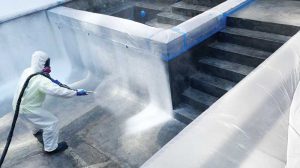 [1]
[1]By Peter Gibson
Most pools before the Second World War were rectangular in design and constructed of formed concrete. Often, these pools were unfinished or adorned with clay tiles. After the war, rudimentary pool paints were used to finish pools, but did not last long, and needed constant reapplication.
Later, rubber-based paints were introduced; also at this time, huge housing developments were afoot, creating suburbs—this is when commercial pool construction began. To speed up the construction process, the idea of gunite and shotcrete was introduced. A large portion of these pools were freeform and did not promote the use of tile, and using paint meant an additional process to smooth the gunite for paint. At this stage, it was decided basic white cement with a marble aggregate would be used in it for strength, which was then trowelled over top the gunite.
Gunite and plaster then standardized the construction process. Over the decades, various other cementitious products were introduced (e.g. specialty plasters such as quartz and pebble aggregate plasters). As a result, cement-based materials came to dominate the pool industry, with construction companies widely adopting them. As time went on, the performance of these cement products was deteriorating. At this point, pool professionals began thinking of other materials to finish pools, and coatings companies started developing coatings specifically for pools. This also became a way to sell into the DIY market, as in, not requiring professional application. The types of coatings sold were simple pool paints that homeowners and pool operators could apply, as it did not require a high level of skill or spray equipment. These products are rolled on, as opposed to industrial-grade products, which require a high skill level and sophisticated plural component equipment.
What are polymeric materials?
Polymeric materials are made of long, repeating chains of molecules that have unique properties depending on the types of molecules employed and bonded together, and the types of bonds. These molecules and bonding types will determine the polymer produced. In the coatings industry, there are hundreds of coating chemistries that will determine the end use of the product. For example, pool coatings are types with subgroups of chemistries that determine the performance and longevity of the coating. Some polymers bend and stretch, while others are hard and tough, such as epoxies and acrylic.
There are three primary groups of polymers:
- Thermosetting—base resins used in the coatings industry. Curing systems are chemical cure or initiators for free radical initiated chain growth polymerization.
- Thermoplastic—plastics for hot tubs and formed plastic products.
- Elastomeric—adhesives and sealants. These are flexibilization products. How these materials react to heat will determine what category they fit into.
Thermoplastics will melt under high heat, while thermoset materials will not melt and retain their form and stay solid under heat once cured.
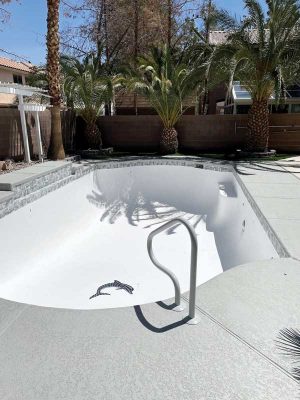 [2]
[2]Types of polymers used in the pool industry
When referring to “epoxy paints,” it is important to bear in mind that epoxies are a chemistry, and not a particular type of paint.
- Simple, inexpensive epoxy pool paints. They need constant reapplication and have a short service life.
- Higher quality two-component epoxies. These have a longer service life.
- High-performance, industrial-grade, two-component, 100 per cent solids, zero volatile organic compounds (VOCs). For these, spray application is the preferred application method. They have a longer service life, but are difficult to apply, and have lengthy cure cycles. They also require a high skill level for the application. The common types of epoxies
are novolac epoxies. - Polyurea. These coatings are well-known for their high elongation and extremely fast cure times—sometimes only seconds long. The only drawback of polyurea coatings is producers have not developed products specifically tailored to the pool industry, and because they are not chlorine-tolerant, there needs to be a topcoat with a different paint to protect against chlorine damage. The resins are also very expensive.
- Polyvinyl chloride (PVC) vinyl liners. Another use of polymeric material are PVC vinyl liners. The basic building block polymers are polyvinyl chloride resin. In this case, the product takes the form of a fabric rather than a coating. Vinyl liners are widely used for new pool construction. Although vinyl liners have been attempted for use for pool renovation, especially in commercial pools, their use is very limited. The reason for this is because the structure of the pool must be changed to accommodate the attachment points for the liner. Also, the odd shapes and contours of pools and spas makes installation more complex and time consuming. Compare this to coatings that are sprayed over concrete and immediately conform to the shape of the vessel—no special termination points are required. In addition, vinyl does not have the long-term performance characteristics of high-performance polymeric coatings as those are easier and less costly to install.
- Polymer glass–reinforced composite coatings. These types of coatings and linings have been around for decades and are extremely durable and have a long service life. A major drawback has been bonding to the concrete.
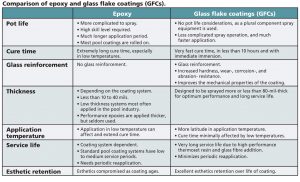 [3]
[3]
Bonding is an issue because high tensile stresses and resin shrinkage cause the lining to pull away from the surface, leading to disbondment. There are two types of glass reinforcement to use. Chopped-glass fibre sprayed through a chopper gun, and the fibreglass mat method where mat is hand-laid over the concrete. These application methods have become obsolete with the introduction of glass flake coatings (GFCs). GFCs have overcome most of the disadvantages of chopped and hand-laid fibreglass coatings in general, and disbondment in particular.
How GFCs are different from epoxy paints
Although GFCs have been used for decades in the industrial protective coatings sector, they are fairly new to the pool industry. They were introduced because of the shortcomings of some epoxy paints. Many pool operators are looking for extraordinary performance and service life, and these coatings cater to those pool owners.
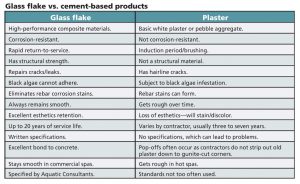 [4]
[4]
GFCs have a glass reinforcement embedded in a thermoset resin and are sprayed as a homogenous mass without a fibreglass mat. The coating application is very fast since the material does not have to be “worked,” saving time and money.1 Spray time is 100 m2 (1,000 sf) in less than an hour. This is an industrial-grade product and should be professionally applied by a certified applicator.
Manufactures now offer specific training to interested pool professionals who want to offer a higher-end product.
The benefits of glass flake in high-performance coatings
- No mat or chop fibreglass.
- Improved thermal stabilization of coatings.
- Increases flexibility.
- Reduces coating shrinkage.
- Glass fibre acts as reinforcement and improves mechanical properties.
- Increases viscosity and film build.
- Fewer passes required.
- Reduces moisture permeation and vapour permeation.
- Extends coating life, delivering a long service life.
- Prevents cracking and peeling.
- Assists in bond promotion.
- Increased hardness, wear-, chemical- and abrasion-resistance.
- Provides a low lifecycle cost without the need for periodic refinishing.
- Superior moisture vapour transmission reduction (MVT).
Reviving a distressed pool: GFC’s versatile solution
The pool under review had been painted numerous times and developed structural cracks, causing leaks. The owner was searching for a solution to remedy the surface esthetics and solve the leakage. The owner was advised to research his options to remediate the problems. Multiple candidate materials came up for review, however, as the pool had structural issues, cementitious materials were not considered. Some of the materials considered for this were heavy-gauge PVC vinyl liner, high-performance, 100 per cent solids, zero VOC’s novolac industrial-grade epoxy, and a polymer composite product, such as a GFC.
After thorough examination of all the polymer products, the owner decided on GFC. It is available in different versions, depending on the condition of the pool. It turned out to be the most versatile product available to remediate distressed/problematic pools. GFC comes in a structural and non-structural version. To address the structural issues in this pool, the structural version was chosen.
Scope of work and solution
The entire pool was lined with hand-laid fibreglass mat that was saturated with a bisphenol A (BPA) epoxy vinyl ester resin (EVER). The laminate was then consolidated using specialized compression rollers, then the entire lining was sanded to remove any sharp glass fibres. Once this operation was completed, the GFC was spray-applied to a thickness of 80 mils. This restoration technique sealed and waterproofed the entire pool, and the GFC finished it off. These procedures stopped the pool from leaking and eliminated ongoing painting.
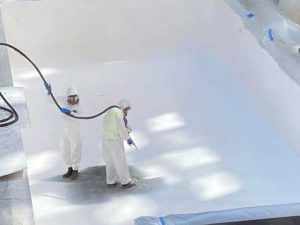 GFC: The ideal solution for commercial spa resurfacing
GFC: The ideal solution for commercial spa resurfacing
This commercial pool operator at a major casino in Las Vegas had ongoing problems with spa surfaces requiring periodic resurfacing using cement-based materials. Common problems in spas are black algae infestation, and severe staining and rough surfaces making for a very uncomfortable bathing experience.
Due to the high temperatures and bather load, the owner was searching for a product which would not require expensive periodic resurfacing and offered excellent esthetic retention. Candidate coatings were evaluated to determine which one had the best lifecycle cost and performance. Vinyl liners, high-performance novolac epoxy, and GFCs were assessed.
Once again, the evaluation showed that GFC would outperform the competing materials in all criteria under examination. High-performance BPA EVER was used to withstand the high water temperature, and offer superior blister resistance, as EVER are well-known for holding up to the abuse in hot commercial spas. The owner was impressed with the outcome, as the GFC enhanced the esthetic and created a clean, inviting look.
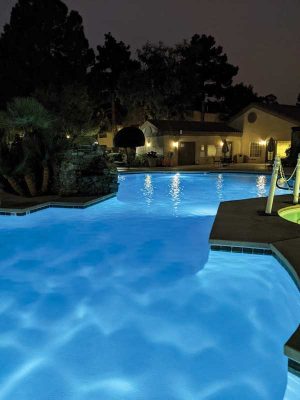 [5]
[5]How the market is shaping innovation
The pool coatings market has stagnated over the years, and no new products have come to market. The introduction of GFCs has changed this. Foundationally, end users desire faster cures, easier application, reduced number of layers, and longer service periods for coating solutions. GFCs simplify the overall process, and provide outstanding performance, productivity, and esthetics retention.
GFCs are a versatile pool coating system because they can be applied to all metals and concrete. The rise of pre-manufactured steel pools for elevated structures, such as hotels and condominiums, make GFCs the ideal finish thanks to its waterproofing properties. Elevated pools are logistically more difficult to work on because of access, so owners want a product that does not require frequent reapplication or disruption to guest services. These coatings are also extremely lightweight compared to cement-based finishes.
Coating characteristics to consider
As a guide, here are some characteristics to consider before selecting a pool coating.
- Weight of coating product. This is of special importance when renovating elevated pools. Polymeric materials are much lighter and stronger than cement-base products.
- Durability, versatility, and potential service life.
- How inert, waterproof, and corrosion-resistant is the material.
- Is the product relatively immune to the damaging effects of pool water and chlorine?
- How forgiving is the coating to out-of-balance water chemistry and pH swings?
- How tolerant is the coating of hot water
in spas?
Hot water is very aggressive on cementitious products and low-end pool paints. GFCs are proven to work well in spas.
- Does the coating contain glass fibre for added strength and durability?
- Is the base resin high-performance or is it a low-end product?
The benefits of high-performance polymer coatings
- The non-porous surface inhibits algae penetration and minimizes staining.
- Long-lasting solution to surface problems.
- Can be applied to steel and concrete.
- Ideal for elevated pools.
- Some versions can remediate structural cracks in concrete.
- Years of field experience has demonstrated that polymeric products can dramatically reduce renovation cost, limit maintenance, and extend the life of a pool or aquatic facility.
Final thoughts
Polymer coatings reduce operational costs for commercial pools and aquatic centres. Upon completion of resurfacing projects, the startup and balance procedure are less complicated and costly when compared to cement-based finishes, and no induction time is required as well.
Pool chemicals are more efficient and less costly as less products are required due to the inert nature of polymeric materials; whereas cement contains minerals that can leach out and form on the surface. A common problem is calcium nodules that form on plaster, making it very rough. Although traditional pool paints have been around for decades, the introduction of polymer composite coatings, especially GFCs, have ushered in a new generation of high-performance coatings for the pool industry.
From the foregoing discussion, it is fascinating to see how polymeric materials had humble beginnings in the pool industry to now, where they have become some of the most sought-after material for pool and spa finishing and resurfacing projects. Today, there is a wide array of options to explore when it comes to polymer coatings for pool and spa projects.
Notes
1 An example of “worked” would be plastering the pool where the plaster is pneumatically applied then “worked” with a trowel. GFC are only sprayed and not “worked” beyond that point.
 Author
Author
Peter Gibson of GRC Pool Coatings has been involved in the pool polymer coatings industry for more than 30 years. He has worked with a broad range of coatings, from simple pool paints to high-performance glass fibre-reinforced coatings and linings. He is also a specifications writer and specifier, as well as an instructor for the application of polymer composite coatings. He can be reached at resinmaster@gmail.com.
- [Image]: https://www.poolspamarketing.com/wp-content/uploads/2023/09/Opener_spray-5.jpg
- [Image]: https://www.poolspamarketing.com/wp-content/uploads/2023/09/Residential-pool.jpg
- [Image]: https://www.poolspamarketing.com/wp-content/uploads/2023/09/comparison-of-epoxy-n-glass-flake-coatings-scaled.jpg
- [Image]: https://www.poolspamarketing.com/wp-content/uploads/2023/09/glass-flake-vs-cement-based-products.jpg
- [Image]: https://www.poolspamarketing.com/wp-content/uploads/2023/09/Opener-2.jpg
Source URL: https://www.poolspamarketing.com/trade/features/evolution-of-pool-coatings-from-clay-tiles-to-high-performance-polymer-finishes/